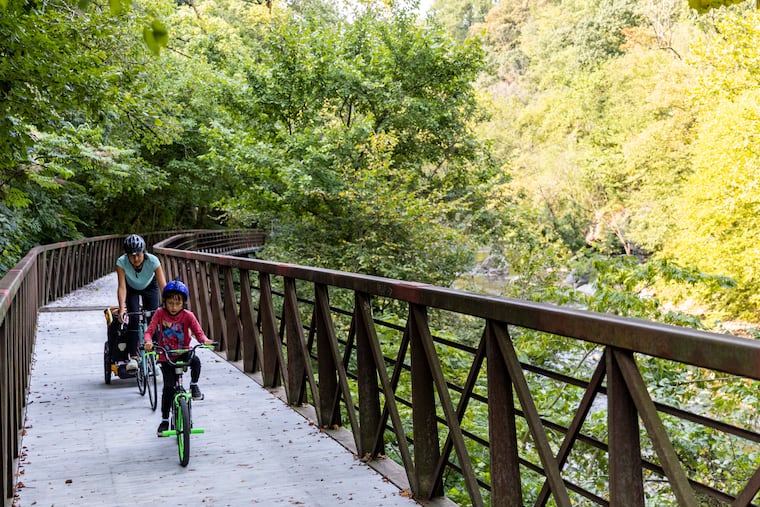4 Wissahickon Valley Trail bridges reopen, restoring a vital link to Center City
The bridges run along the Wissahickon Valley Trail, ultimately serving to connect Forbidden Drive with the Schuylkill River Trail.

Philadelphia Parks and Recreation on Friday officially reopened four pedestrian and bicycle bridges that run parallel to Lincoln Drive along the Wissahickon Creek, restoring a vital, no-traffic connection to Center City used by thousands, which had been closed for 16 months.
Officials said the $1.2 million project, which began March 1, 2021, was necessary because the bridges were at the end of their life spans. The bridges were originally projected to reopen by the end of last year, but construction was hampered by supply chain issues, the pandemic, the remnants of Hurricane Ida, a labor shortage, and the discovery that one bridge was in much worse condition that expected.
For Nicole Brunet, policy director for the Bicycle Coalition of Greater Philadelphia, the reopening served as a reconnection.
“I use it all the time recreationally, especially in the summer,” Brunet said. “This is a main way that people from the Northwest come into Center City. So this is a really big moment.”
Where are the bridges?
Three of the bridges at the Ten Box stone structure at Lincoln and Forbidden Drives are successive, running about 300 feet total with only a small gap between each. A fourth bridge, about a quarter mile south, spans 10 feet and is the only one to cross the Wissahickon Creek.
Altogether, the bridges run along the Wissahickon Valley Trail, ultimately serving to connect Forbidden Drive with the Schuylkill River Trail. Prior to their closure, about 7,000 pedestrians and 5,600 cyclists used the trail containing the bridges in Jan. 2021, the last available data before the bridges were closed, according to the Delaware Valley Regional Planning Commission.
Patrick Morgan, first deputy commissioner for Parks & Recreation, said the bridges “provide some of the most stunning views and access to nature” along the 1,800-acre Wissahickon Valley Park and its 50 miles of trails.
Morgan noted the “unique obstacles” the construction presented, as officials said Ida at one point wiped out sections of the trail. The bridge that crosses the creek was in such poor condition that they could not put equipment on top of it, and had to figure out other methods to complete construction.
A ‘linchpin’
Ruffian Tittman, executive director of the nonprofit Friends of the Wissahickon, which helps support the park, credited Parks & Rec for not only undertaking the project but securing the funds.
She said the bridges are “better than ever” with a new nonslip surface.
Francesco Cerrai, the project coordinator for the city, said the new bridges have steel trusses with aluminum decking designed to prevent slips — a frequent complaint about the old wooden decking.
Jeannette Brugger, bicycle and pedestrian coordinator for the city’s Office of Transportation, Infrastructure and Sustainability, called the bridges a “linchpin” in the trail system.
Sarah Clark-Stuart, executive director of the Bicycle Coalition, said the closure “jolted a lot of people into understanding how important the path is to probably a couple of thousand people.”
Clark-Stuart said the bridges are part of the growing Circuit Trails network, an effort to eventually connect 800 miles of trails through nine counties including into South Jersey.
Regular cyclist Josh Haims, who uses the bridge multiple times a week for exercise or to commute, said the closure was “an inconvenience for many” made worse by the delays, but he was happy to be able to ride the trail without detours once again.
“I am glad the bridges are reopening. … We hope these bridges last for years to come,” he said.
This article has been corrected to state that 7,000 pedestrians and 5,600 cyclists used the trail in Jan. 2021, prior to the closure of the bridges. The article had stated that figure as the annual number of users.